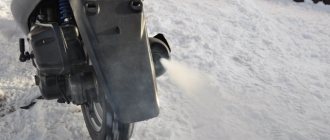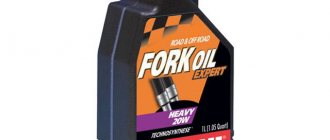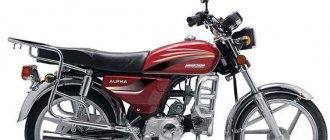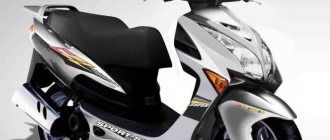Correct scooter tire pressure
To improve tire performance, increase engine efficiency, and ensure road stability, it is necessary to maintain the correct tire pressure.
They are designed in such a way that their shape must be maintained by internal pressure. If a tire is inflated correctly, it wears evenly and there is no deformation of the tread or sidewall of the tire. An overinflated tire has a smaller contact patch, which negatively affects directional stability, especially when cornering. The center portion of the tread will experience the most wear. The tire becomes very rigid and transfers vibrations from bumps on the road more strongly to the body of the scooter. The suspension suffers: bearings and silent blocks, as well as shock absorbers.
If the tire is underinflated, then the grip on the road is also insufficient, wear occurs on the side parts of the tread. Due to increased friction, the tire overheats, which leads to the destruction of the carcass. A 20% lack of pressure results in a 30% reduction in tire service life. In addition, rolling resistance increases, resulting in increased fuel consumption.
Therefore, the pressure must be maintained at the recommended level. If the tire fits well to the rim and has no punctures, then it practically does not deflate. However, the pressure must sometimes be checked, at least visually. If you get on a scooter and the tire is noticeably deformed, it means that it urgently needs to be inflated.
To measure pressure, instruments called pressure gauges are used. They can be mechanical (pointer) or digital electronic. Pressure gauges built into compressors are usually not very accurate. But they are suitable for a scooter.
To how many atmospheres should a scooter wheel be inflated?
The following figures are usually used: the front wheel of a scooter is inflated to 1.8 atm, and the rear wheel - to 2 atm. In winter, the pressure can be reduced by 0.1-0.2 atm.
You should always inflate a “cold” tire, that is, after a long period of inactivity, since when driving it heats up and the pressure increases.
Please note: This article and the images in it are subject to copyright. Partial or complete reproduction on other resources without permission is prohibited.
Tire pressure table
On each tire you can find the recommended pressure , which should be adhered to. Typically this is 2 atm at the rear and 1.75 atm at the front. In the table you can find out what pressure should be depending on the tire size.
| Wheel size | Tire pressure, front/rear, kgf/cm2 (atm.) | |
| Normal load | Full load | |
| 100/60-10 | 2,2/2,3 | 2,3/2,4 |
| 130/60-13 | 1,8/2,0 | 2,0/2,2 |
| 130/70-12 | 2,2/2,3 | 2,3/2,4 |
| 120/70-12 | 2,25/2,3 | 2,3/2,4 |
| 110/70-12 | 2,2/2,3 | 2,3/2,4 |
| 120/80-12 | 1,8/2,0 | 2,0/2,2 |
| 130/70-10 | 1,8/2,0 | 2,0/2,2 |
| 100/90-10 | 1,9/2,1 | 2,0/2,2 |
| 120/90-10 | 1,8/2,0 | 2,0/2,2 |
| 130/90-10 | 1,9/2,1 | 2,0/2,2 |
| 3.0x10 | 1,75/2,0 | 2,0/2,1 |
| 3.50x10 4PR | 2,5/2,5 | 2,6/2,6 |
Indicators of air pressure that needs to be pumped into the wheels of popular models of 2T and 4T scooters:
| Model | Front wheel, atm | Rear wheel, atm |
| Moped Alpha 50cc | 1,72 | 2,2 |
| Moped Delta | 1,48 | 2,6 |
| Stealth Zion (as well as other Chinese 150cc scooters) | 1,7 | 2 |
| Honda Dio | 1,6 | 1,97 |
| Honda Tact | 1,58 | 1,95 |
Tire pressure monitoring
In fact, you should check the pressure before each trip, not necessarily with a pressure gauge, even just by eye, simply pressing the entire weight of your body on the seat, check if there is a significantly flat tire. The tire may have been punctured or otherwise damaged during your last trip. If this is the case, then be sure to fix the puncture; if you cannot do this manually, inflate the wheel a little more than the recommended rate and go to a tire shop.
Sometimes, when inflating tires, we don’t even think about the standards that must be observed. So, at low pressure , fuel consumption increases significantly, controllability changes dramatically, and the scooter begins to “wobble.” In fact, such behavior of technology is very dangerous, and you should not allow such phenomena. In addition, the service life of the tire and tread itself is significantly reduced. There is a chance of disassembly if it is a tubeless camera. In this case, you will not be able to inflate the tire, even if you took a pump with you. Increased tire pressure also has negative effects on both handling and wear. At the same time, the scooter's grip on the ground decreases, and the slightest unevenness on the road can lead to a fall.
What pressure should be in the tires of a 50cc scooter?
To improve tire performance, increase engine efficiency, and ensure road stability, it is necessary to maintain the correct tire pressure. They are designed in such a way that their shape must be maintained by internal pressure. If a tire is inflated correctly, it wears evenly and there is no deformation of the tread or sidewall of the tire.
An overinflated tire has a smaller contact patch, which negatively affects directional stability, especially when cornering. The center portion of the tread will experience the most wear. The tire becomes very rigid and transfers vibrations from bumps on the road more strongly to the body of the scooter. The suspension suffers: bearings and silent blocks, as well as shock absorbers.
If the tire is underinflated, then the grip on the road is also insufficient, wear occurs on the side parts of the tread. Due to increased friction, the tire overheats, which leads to the destruction of the carcass. A 20% lack of pressure results in a 30% reduction in tire service life. In addition, rolling resistance increases, resulting in increased fuel consumption.
Therefore, the pressure must be maintained at the recommended level. If the tire fits well to the rim and has no punctures, then it practically does not deflate. However, the pressure must sometimes be checked, at least visually. If you get on a scooter and the tire is noticeably deformed, it means that it urgently needs to be inflated.
To measure pressure, instruments called pressure gauges are used. They can be mechanical (pointer) or digital electronic. Pressure gauges built into compressors are usually not very accurate. But they are suitable for a scooter.
To how many atmospheres should a scooter wheel be inflated?
The following figures are usually used: the front wheel of a scooter is inflated to 1.8 atm, and the rear wheel - to 2 atm. In winter, the pressure can be reduced by 0.1-0.2 atm.
You should always inflate a “cold” tire, that is, after a long period of inactivity, since when driving it heats up and the pressure increases.
Please note: This article and the images in it are subject to copyright. Partial or complete reproduction on other resources without permission is prohibited.
What pressure should the scooter tires have?
Many scooter owners who have not previously used this type of equipment do not think about the fact that scooter tires must have a certain degree of pressure. In general, the tire of any vehicle must have optimal performance according to the recommendations, so the scooter must also comply with generally accepted standards. If the pressure in the scooter tires is correct, their service life increases, and the scooter's dynamics and comfort also improve. If the pressure is incorrect, the tire will get an uneven shape.
What pressure should the scooter tires have, and how often should they be checked? In fact, you will have to check the tires before each trip, especially if it is long. It is enough to press well on the seat and see: is the tire flat? During the last movement, the tire could break, and after a long period of inactivity it could simply go flat. In this case, it is recommended to pump up the tire and go to the nearest tire shop.
In some cases, we inflate the tire “by eye”, forgetting that it is possible to overinflate it. An overinflated tire becomes hard and is unable to adhere tightly to the surface, that is, the road. This is especially noticeable at high speed and during sharp turns, if the pressure is high, there is a risk of falling.
Also, an overinflated tire will cause rapid wear of the tread, and wear will only occur in the center of the tire. Accordingly, high pressure will not be able to provide good shock absorption; you will feel every hole. This entails further damage to the shock absorbers.
If your tire is flat, the wear will not be on the entire perimeter, but exclusively on the side parts. Also, too close contact with the road makes the scooter move slower, the motor will have to put more load on the wheels, and fuel consumption increases. In general, you can inflate a tire “by eye”, the main thing is that you regularly check its condition. But the tire pressure of a maxi scooter or a 150cc scooter must meet certain indicators, which we will discuss below.
Tire pressure in winter
If you use the scooter in winter, then it is advisable to reduce the pressure
. Please also note that when driving, the tire heats up, and these same atmospheres that you measured before the trip will increase slightly. Hence, it is recommended to take measurements when cold. In the cold season, the indicator drops, but the tires also “tanner”.
It is impossible to restore the safety and performance of a tire if the tread or sidewalls are punctured or damaged by some road debris. When the cord layer has been punctured or damaged, the strength of the tire is significantly reduced. And due to uneven road surfaces, tires do not wear evenly laterally or around the circumference. This uneven wear can negatively impact cornering and handling performance. Make sure your tires have sufficient tread.
Refer to your operator's manual for the correct tread depth. Question 4: Should new tires be damaged? They must be driven at least 62 miles to break them. A protective layer is applied to the surface of new tires and may cause slipping during normal operation.
Many scooter owners who have not previously used this type of equipment do not think about the fact that scooter tires must have a certain degree of pressure. In general, the tire of any vehicle must have optimal performance according to the recommendations, so the scooter must also comply with generally accepted standards. If the pressure in the scooter tires is correct, their service life increases, and the scooter's dynamics and comfort also improve. If the pressure is incorrect, the tire will get an uneven shape.
Although the tire mounted on the wheel is perfectly round, the weight distribution is not even. The lightest point of the tire is marked with a small paint on the sidewall of the tire. This point should be aligned with the valve stem when mounting the tire. Tires are made of rubber and, depending on the composition of the tire wax, this can wear out the rubber or cause cracks in the tire.
Tires and durability are one of the biggest responsibilities of a racer. Your tire's ability to displace water during rainstorms is especially important. Good, even tread depth helps the tire dissipate water and greatly reduces the likelihood of water planing. In dry conditions, a good tire will also increase traction and reduce braking distances. Here at the shop, we recommend that the typical racer check his tire pressure, check his oil regularly, and clean his mirrors regularly. In fact, we often hear clients claim that we force it on them.
What pressure should the scooter tires have, and how often should they be checked? In fact, you will have to check the tires before each trip, especially if it is long. It is enough to press well on the seat and see: is the tire flat? During the last movement, the tire could break, and after a long period of inactivity it could simply go flat. In this case, it is recommended to pump up the tire and go to the nearest tire shop.
But keep in mind that maintenance for many only occurs every few months or even once a year. Our workshop team relies on strong relationships with these brands to help us offer the best tire at the best price to our customers. The quality of the product and the feedback we receive from our customers assures us that we can provide the best available clutch and wear combinations for the scooter market.
Simply fill out the form below and we will get back to you with a quote in no time. In the meantime, here's a little information about how the latest scooter tires are built. Patented technology achieves both front and rear tire structure using a radial casing and single-ply steel belt. Depending on the direction in which the tire is rolled, the tape is wound in a circle around the carcass, providing an angle close to 0°.
In some cases, we inflate the tire “by eye”, forgetting that it is possible to overinflate it. An overinflated tire becomes hard and is unable to adhere tightly to the surface, that is, the road. This is especially noticeable at high speed and during sharp turns, if the pressure is high, there is a risk of falling.
Also, an overinflated tire will cause rapid wear of the tread, and wear will only occur in the center of the tire. Accordingly, high pressure will not be able to provide good shock absorption; you will feel every hole. This entails further damage to the shock absorbers.
The advantages of using steel are its extremely high stiffness and the ability to customize the winding intervals, allowing for differentiated stiffness distribution from shoulder to crown. Always inflate your tire to the correct pressure. Be sure to check your cold infusion pressure frequently, i.e. once a week. Even though many scooter riders love to work on their scooters, many rarely remember their tire pressure. Correct pressure is critical for safe handling.
Inflation or extreme tire pressure will reduce ride comfort and reduce the size of the tire's contact area with the road. Inflation or too little air pressure will result in poor handling and the bike will tend to wander. Incorrect and insufficient tire pressure will also cause rapid tire wear, increased fuel consumption, reduced top speed and reduced control and longer braking distances. Be sure to check the tire pressure of your tires weekly.
If your tire is flat, the wear will not be on the entire perimeter, but exclusively on the side parts. Also, too close contact with the road makes the scooter move slower, the motor will have to put more load on the wheels, which increases. In general, you can inflate a tire “by eye”, the main thing is that you regularly check its condition. But the tire pressure of a 150cc scooter must meet certain indicators, which we will discuss below.
During this operating period, sudden acceleration, heavy braking and hard turning should be avoided. The tread wear indicator can be tricky, but it is an ideal indicator of the remaining tread wear on your tires. This is what we use to estimate the remaining life of your tread. The easiest way to describe your wear indicator is to think of your tread as a hill and the bottom of the groove as the floor of a valley. If you were to wear the tread to the right all the way to the valley floor, you simply have a bald tire.
Cleverly, modern tires have a slight tread, which is located at a height of about 2 mm above the floor level. These 2mm buds are only 10mm long, but you'll find that if you look closely at a few areas of the tread. These are typically located in the middle of the tread and also towards the outer edges, so you get an idea of how your tire is wearing. If the tread is worn enough to even show a wear indicator, you will need a tire replacement immediately. If you're not sure, just come in and see us and we can evaluate your tires for free.
Calculation of the recommended value
How to use the calculator?
The calculator is working in test mode! If you find an error in the indicators or want to leave suggestions, please send them through the feedback form on the Feedback page or the VK group! Errors with evidence (photos, screenshots, links) are accepted! All information presented on the site is for informational purposes only! Thanks for understanding!
Contents
- 1 Why monitor blood pressure readings
- 2 Rules for maintaining optimal tire pressure
- 3 Control: what to measure and what to measure in
- 4 What causes incorrect air pressure in the wheels
- 5 Maintenance Tips
Why monitor blood pressure readings?
Any scooterist is interested in safe movement and high-quality control of his moped. Concerns about saving money also play an important role. Both of these, and the third, largely depend on maintaining optimal tire pressure. Proper tire inflation improves the maneuverability and maneuverability of any vehicle, including a scooter. If tires are inflated correctly, the treads are protected from premature wear.
So, what pressure should your scooter tires have?
Rules for maintaining optimal tire pressure
To be sure that the tires are inflated correctly, it is necessary to measure the pressure at least every two weeks, and always before each long trip.
If you have not used the moped for a long time, you should also check the pressure gauge readings with the required values. Even at rest, air leakage can occur due to pores in the rubber and the natural technical clearances of the wheel.
The variety of scooter models, differences in their size, weight and load that they are capable of carrying do not allow us to give the same recommendations for optimal tire inflation for mopeds with a capacity of 50, 150, etc. cubes at the same time. Therefore, we suggest you use a specially developed table of tire pressure parameters depending on the technical characteristics of your scooter:
Important! The parameters indicated on the tire are the maximum permissible value for this rubber. Do not use it as a reference when inflating moped tires.
Tire pressure table
On each tire you can find the recommended pressure , which should be adhered to. Typically this is 2 atm at the rear and 1.75 atm at the front. In the table you can find out what pressure should be depending on the tire size.
| Wheel size | Tire pressure, front/rear, kgf/cm2 (atm.) | |
| Normal load | Full load | |
| 100/60-10 | 2,2/2,3 | 2,3/2,4 |
| 130/60-13 | 1,8/2,0 | 2,0/2,2 |
| 130/70-12 | 2,2/2,3 | 2,3/2,4 |
| 120/70-12 | 2,25/2,3 | 2,3/2,4 |
| 110/70-12 | 2,2/2,3 | 2,3/2,4 |
| 120/80-12 | 1,8/2,0 | 2,0/2,2 |
| 130/70-10 | 1,8/2,0 | 2,0/2,2 |
| 100/90-10 | 1,9/2,1 | 2,0/2,2 |
| 120/90-10 | 1,8/2,0 | 2,0/2,2 |
| 130/90-10 | 1,9/2,1 | 2,0/2,2 |
| 3.0x10 | 1,75/2,0 | 2,0/2,1 |
| 3.50x10 4PR | 2,5/2,5 | 2,6/2,6 |
Indicators of air pressure that needs to be pumped into the wheels of popular models of 2T and 4T scooters:
| Model | Front wheel, atm | Rear wheel, atm |
| Moped Alpha 50cc | 1,72 | 2,2 |
| Moped Delta | 1,48 | 2,6 |
| Stealth Zion (as well as other Chinese 150cc scooters) | 1,7 | 2 |
| Honda Dio | 1,6 | 1,97 |
| Honda Tact | 1,58 | 1,95 |
Control: what to measure and what to measure in
Mechanical or electronic pressure gauges are used to measure the pressure in scooter tires. The accuracy class of these devices varies, so it is better not to save money and purchase an expensive but high-quality device. In the future, such a purchase will save you from more significant expenses.
Important! Do not try to gauge tire inflation by squeezing the tire with your fingers. The rigidity of the wheel at a pressure level of more than 1.5 atmospheres is such that it is impossible to determine the true indicators.
There are several accepted units for measuring pressure. On the territory of Russia, the main one is Atmosphere (1 atm. = 1 kgf/sq. cm), which is almost equal to the European Bar (1 bar = 0.98 atm). In the USA, PSI is used (1 psi = 1 pound/square inch or pound/square inch). Tire manufacturers use Kilopascal (1 kPa = 6.895 psi).
Units of measurement are converted into each other using the following formulas:
- 1 psi = 0.068 atm
- 1 atm = 14.696 psi
- 1 atm = 101.348 kPa
- 1 bar = 0.98 atm
Maintenance Tips
To extend the life of your scooter's wheels, increase your own safety when riding and avoid additional costs for maintaining and operating your vehicle, follow a number of simple rules:
- control the pressure in the moped tires, avoiding both underinflated and overinflated wheels;
- do not forget to periodically pump up the wheels of a scooter that is temporarily not in use. This will help prevent cracks from appearing in the rubber and protect it from premature aging. The optimal pressure during this period is 1.5-2.0 atmospheres;
- be sure to double-check the pressure gauge readings before driving the scooter after it has been idle for a long time;
- Take measurements only on “cold” tires.
» frameborder=»0″ allow=»autoplay; encrypted-media»allowfullscreen>»width=»320″ height=»240″>
What pressure should be in scooter tires?
Many scooter drivers do not pay enough attention to such an important procedure in scooter maintenance as checking tire pressure. They neglect this important work and leave it for later. And in vain... The controllability of the scooter directly depends on the correct pressure in the tires of the scooter and therefore your safety, especially since doing this work will not take much of your time.
How often should blood pressure be monitored?
It is advisable, of course, to check it daily, but... As always, not once, then later, then I forgot, my advice to you: check at least once a week, and if your scooter has been standing for a long time, then be sure to check the pressure before the trip.
I advise you to check the pressure value in the instructions for your scooter, but if for some reason you do not know the recommended value, you can use the general recommendations that are suitable for most scooter models.
Front wheel: 1.8 kg.cm Rear wheel: 2.2 kg.cm
To carry out this work is very easy and quick, unscrew the protective cap on the wheel valve, take a special pressure gauge (I use the most ordinary one) and holding the valve, press the pressure gauge to it; if the pressure is below normal, inflate the wheel, and if it is higher, deflate it.
Check on the front wheel.
Now on the rear wheel.
After checking, do not forget to replace the protective caps.
Scooter tire pressure: table
To achieve optimal performance, you need to have a pressure gauge; before using it, pay attention to its condition; the device must accurately display the information. As a standard, a scooter tire should have the following pressures.
Have you ever wondered what the difference is between front and rear scooter tires? Take a look at some interesting moments when our workshop selects tires for your scooter. Tire pressure is the most easily adjusted variable on your motorcycle, and also one of the most important. But the vast majority of us are guilty of neglecting it, and even if we check it regularly, failing to take full advantage of adjusting it. Here are 5 things you need to know about motorcycle tire pressure.
Source mirhat.ru











